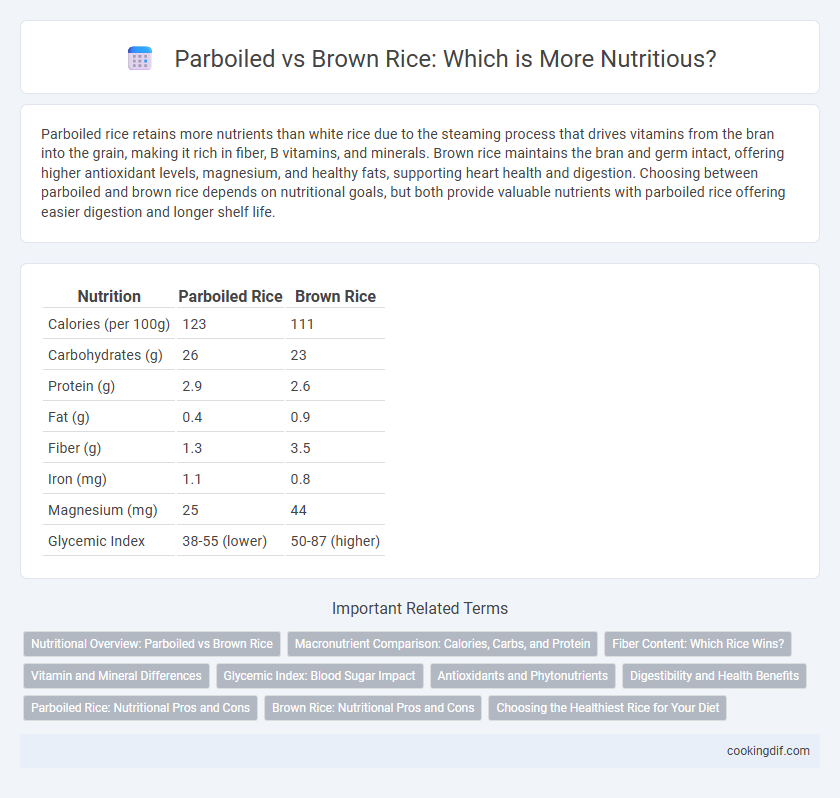Parboiled rice retains more nutrients than white rice due to the steaming process that drives vitamins from the bran into the grain, making it rich in fiber, B vitamins, and minerals. Brown rice maintains the bran and germ intact, offering higher antioxidant levels, magnesium, and healthy fats, supporting heart health and digestion. Choosing between parboiled and brown rice depends on nutritional goals, but both provide valuable nutrients with parboiled rice offering easier digestion and longer shelf life.
Table of Comparison
| Nutrition | Parboiled Rice | Brown Rice |
|---|---|---|
| Calories (per 100g) | 123 | 111 |
| Carbohydrates (g) | 26 | 23 |
| Protein (g) | 2.9 | 2.6 |
| Fat (g) | 0.4 | 0.9 |
| Fiber (g) | 1.3 | 3.5 |
| Iron (mg) | 1.1 | 0.8 |
| Magnesium (mg) | 25 | 44 |
| Glycemic Index | 38-55 (lower) | 50-87 (higher) |
Nutritional Overview: Parboiled vs Brown Rice
Parboiled rice retains more nutrients than regular white rice due to its soaking and steaming process, which preserves vitamins and minerals, especially B vitamins and iron. Brown rice, being a whole grain, contains higher fiber content, essential fatty acids, and antioxidants, contributing to better heart health and digestion. Both options offer distinct nutritional advantages, with parboiled rice providing enhanced mineral retention and brown rice delivering superior fiber and natural nutrient density.
Macronutrient Comparison: Calories, Carbs, and Protein
Parboiled rice contains about 130 calories, 28 grams of carbohydrates, and 4 grams of protein per cooked cup, offering a firmer texture with a slightly higher protein content than white rice. Brown rice provides approximately 215 calories, 45 grams of carbohydrates, and 5 grams of protein per cooked cup, delivering more fiber and nutrients due to the intact bran layer. The macronutrient profile makes brown rice a more nutrient-dense option with higher calories and carbs, while parboiled rice offers a moderate balance suitable for controlled calorie intake.
Fiber Content: Which Rice Wins?
Parboiled rice retains more fiber than regular white rice due to the steaming process that moves nutrients from the bran to the grain, but brown rice still outperforms parboiled rice in fiber content because it preserves the entire bran layer. Brown rice typically contains around 3.5 grams of fiber per serving, compared to parboiled rice's approximate 1.5 grams per serving. For those prioritizing fiber intake to support digestive health and regulate blood sugar, brown rice is the superior nutritional choice.
Vitamin and Mineral Differences
Parboiled rice retains more vitamins and minerals than brown rice due to its unique steaming process, which drives nutrients from the bran into the grain. It contains higher levels of B vitamins, such as thiamine and niacin, along with increased iron and calcium content. Brown rice, while rich in fiber and antioxidants, has lower bioavailability of these essential vitamins and minerals because the bran remains intact without nutrient migration.
Glycemic Index: Blood Sugar Impact
Parboiled rice has a lower glycemic index (GI) compared to brown rice, resulting in a slower rise in blood sugar levels after consumption. Brown rice, rich in fiber and nutrients, has a moderate GI but may cause a quicker glucose spike than parboiled rice. Choosing parboiled rice can be beneficial for better blood sugar control and sustained energy release.
Antioxidants and Phytonutrients
Parboiled rice retains more antioxidants and phytonutrients compared to regular white rice due to its unique processing method, which drives nutrients from the bran into the grain. Brown rice, however, contains higher levels of natural phytonutrients and antioxidants since it remains minimally processed with the bran layer intact. Consuming brown rice provides a richer source of vitamin E, flavonoids, and phenolic acids, essential for combating oxidative stress and supporting overall health.
Digestibility and Health Benefits
Parboiled rice offers enhanced digestibility due to its partial gelatinization process, which breaks down starches making it easier on the digestive system compared to brown rice. Brown rice retains bran and germ layers, providing higher fiber, antioxidants, and essential nutrients that support heart health and regulate blood sugar levels. While brown rice excels in nutritional density, parboiled rice balances moderate nutrient retention with improved digestibility for sensitive digestive conditions.
Parboiled Rice: Nutritional Pros and Cons
Parboiled rice undergoes a unique steaming process that drives nutrients from the bran into the grain, resulting in higher retention of vitamins such as B-complex and minerals like magnesium compared to regular white rice. This process enhances its glycemic index, making parboiled rice a better option for blood sugar management than standard white rice but less favorable than brown rice, which contains more fiber and antioxidants. Despite its nutritional benefits, parboiled rice has a slightly lower fiber content than brown rice, which may influence digestion and satiety levels.
Brown Rice: Nutritional Pros and Cons
Brown rice contains higher levels of fiber, magnesium, and antioxidants compared to parboiled rice, supporting better digestion and heart health. Its intact bran layer contributes to a lower glycemic index, aiding blood sugar control and sustained energy release. However, brown rice also contains phytic acid, which may reduce mineral absorption, and requires longer cooking times than parboiled rice.
Choosing the Healthiest Rice for Your Diet
Parboiled rice retains more nutrients than white rice by soaking and steaming the grains before milling, resulting in higher levels of vitamins B1, B6, and minerals like magnesium. Brown rice preserves the bran and germ, delivering more fiber, antioxidants, and essential fatty acids that support digestion and heart health. Choosing the healthiest rice depends on your nutritional goals: parboiled rice offers improved nutrient retention with a firmer texture, while brown rice provides maximum fiber and phytonutrients for enhanced metabolic benefits.
Parboiled vs Brown rice for nutrition Infographic

 cookingdif.com
cookingdif.com